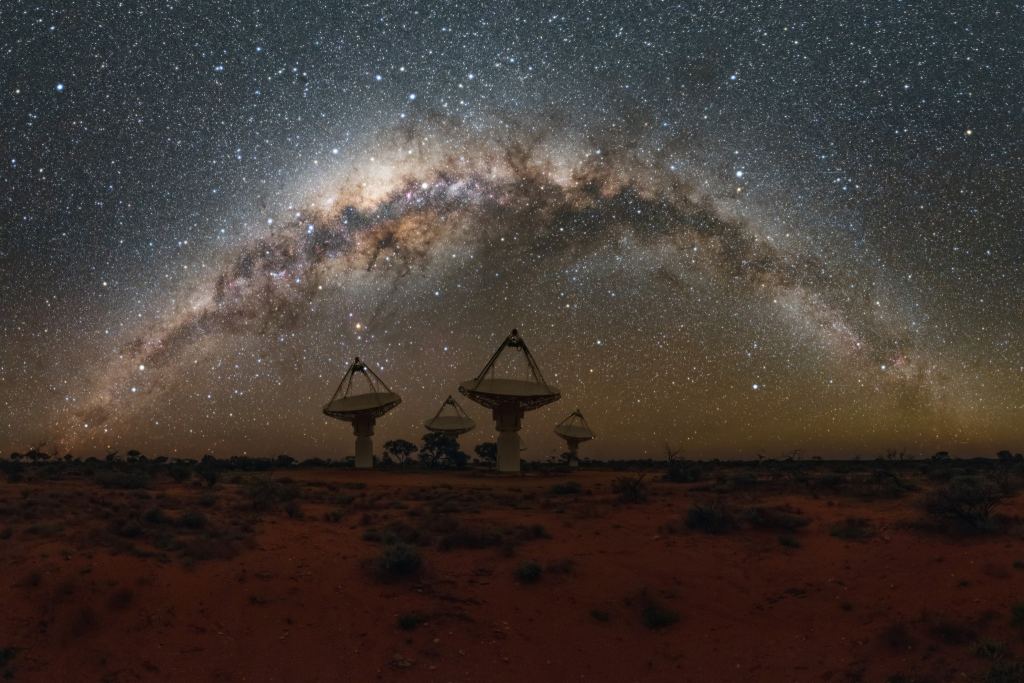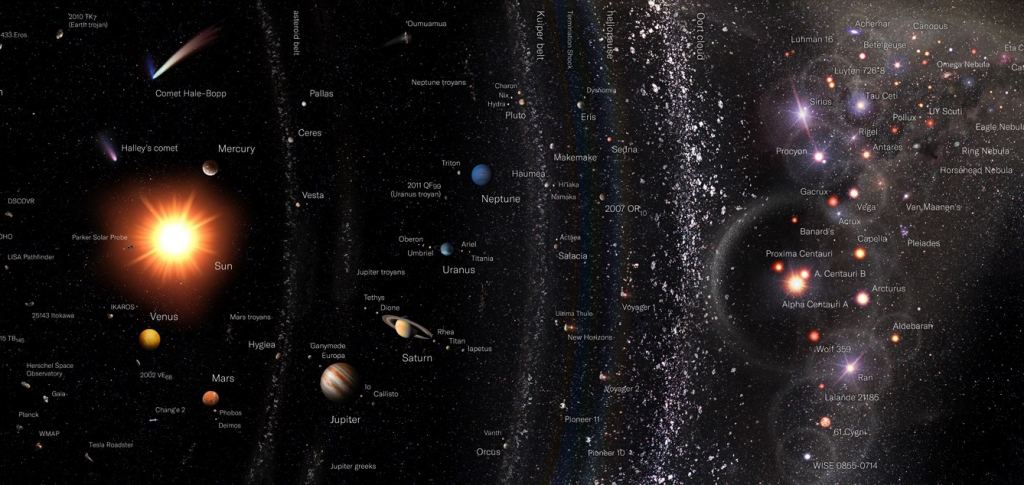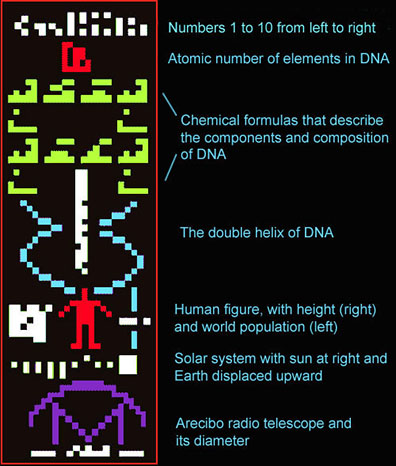Welcome back to our Fermi Paradox series, where we take a look at possible resolutions to Enrico Fermi’s famous question, “Where Is Everybody?” Today, we examine the possibility that Earth hasn’t been visited by aliens because interstellar travel is not very practical!
In 1950, Italian-American physicist Enrico Fermi sat down to lunch with some of his colleagues at the Los Alamos National Laboratory, where he had worked five years prior as part of the Manhattan Project. According to various accounts, the conversation turned to aliens and the recent spate of UFOs. Into this, Fermi issued a statement that would go down in the annals of history: “Where is everybody?“
This became the basis of the Fermi Paradox, which refers to the disparity between high probability estimates for the existence of extraterrestrial intelligence (ETI) and the apparent lack of evidence. Since Fermi’s time, there have been several proposed resolutions to his question, which includes the Dark Forest Hypothesis, where extraterrestrial civilizations are deliberately avoiding contact.
For most of us, the starry skies and the heavenly orbs that are the planets of our Solar System are awe-inspiring and make us feel at peace. To imagine that there are similar worlds out there in neighboring star systems, where other forms of life look at the sky and experience similar feelings, is especially inspiring! But what if this is just a whole lot of naive romanticism, and the Universe is actually a dark and dangerous place?
“It’s Not Safe Out Here”
Fans of Star Trek TNG will instantly recognize the name Q, a member of an omnipotent species of the same name. Normally, he was a cruel prankster. But from time to time, his tough-love approach was actually instructive. In one episode in particular (S2E16, “Q Who?”), he summed up what it takes to “boldly go where no one has gone before”:
“If you can’t take a little bloody nose, maybe you ought to go back home and crawl under your bed. It’s not safe out here. It’s wondrous, with treasures to satiate desires both subtle and gross. But it’s not for the timid.”
Far from just being good writing, these words reflect a popular attitude that we humans have about the unknown. The unknown fascinates and frightens us. Beyond the boundaries of what is known, words like “hic sunt dracones” (“Here be Dragons”) are often applied. To be clear, this term did not suggest that actual dragons (or other mythological creatures that were used) inhabited certain parts of the world.
Rather, it was an anachronistic tool to convey how uncharted areas of maps contained potential dangers. And the sentiment is hardly lost when it comes to modern exploration. Words like Rim, Edge, Fringe, and Verge, Beyond, Perimeter, and Periphery all conjure up feelings of intrigue and anxiety – no doubt, in different measures for different people. So really, is the “Great Silence” a problem or a blessing?

Origin
This particular proposed resolution to Fermi’s Paradox question is a very recent addition. It takes its name from the novel The Dark Forest by famed Chinese science fiction writer Liu Cixin. This book is the second installment in the Remembrance of Earth’s Past series, which deals with the prospect of an impending alien invasion. In a fascinating twist, this invasion was actually invited by a group of disillusioned humans!
The second novel opens with a conversation between a young sociology professor and former astronomer (Luo Ji) and the mother of a deceased friend (Ye Wenjie). While visiting the grave of Ye’s daughter, Luo is surprised when Ye suggests that she create a new field called “Cosmic Sociology.” According to Ye, at the heart of this field is a key assumption in the Drake Equation:
“Suppose a vast number of civilizations distributed throughout the universe, on the order of the number of observable stars. Lots and lots of them. Those civilizations make up the body of a cosmic society. Cosmic sociology is the study of the nature of this super-society.”
Alongside this, Ye introduces two key axioms, which state that: 1) survival is the primary need of civilizations, and 2) civilizations continuously grow and expand, but the total matter in the universe remains constant. In other words, the finite nature of resources will ultimately pit one civilization against another as they all struggle to sustain their growth.

This alone will not make conflict inevitable, but Ye introduces two other assumptions to the mix: “Chains of Suspicion” and “Technological Explosion.” Basically, civilizations could essentially be either malevolent or benevolent, depending on a number of factors. For their part, malevolent civilizations are likely to attack others due to their nature and/or the desire for territory, resources, etc.
Benevolent civilizations, in contrast, are not likely to attack others unless they feel threatened. But when meeting other civilizations, where communication is extremely difficult and intentions cannot be gauged, they will naturally consider if it is best to “shoot first and ask questions later.” They could also feel threatened by the prospect that the other civilization (while seemingly gentle) could be entertaining these same fears.
If open communication exists, then conflict could be averted and tensions diffused. But given the time-lag involved with any attempt at interstellar communications, civilizations that are light-years apart are unlikely to resolve their fears quickly. Ultimately, this creates a chain of suspicion where both sides are left considering if it would be wise to attack first until one of them finally does.
The other assumption involves the level of technological development a potential enemy civilization might have. Given how long it would take to reach even the nearest stars, any fearful civilization would likely conclude that it would be futile to send a fleet of warships to attack another species. By the time they arrived, the attacker’s technology would not have matured one bit, while the defender would have decades or centuries to progress.
Under these circumstances, which are unique to the interstellar realm, any intelligent civilization is likely to conclude that it is best to remain quiet and not reveal oneself. Liu summarizes this scenario with a metaphor, from which the novel (and the Fermi hypothesis it inspired) takes its name:
“The universe is a dark forest. Every civilization is an armed hunter stalking through the trees like a ghost, gently pushing aside branches that block the path and trying to tread without sound. Even breathing is done with care. The hunter has to be careful, because everywhere in the forest are stealthy hunters like him.
“If he finds other life — another hunter, an angel or a demon, a delicate infant or a tottering old man, a fairy or a demigod — there’s only one thing he can do: open fire and eliminate them. In this forest, hell is other people. An eternal threat that any life that exposes its own existence will be swiftly wiped out. This is the picture of cosmic civilization. It’s the explanation for the Fermi Paradox.“
A similar appraisal was made by Charles R. Pellegrino and George Zebrowski in their hard science fiction novel The Killing Star. As part of a thought experiment, the authors present the reader with two points in the story and asked if they agree. First, they posit that a species’ own survival is more important to them than the survival of another species – which would seem like a foregone conclusion.

Second, they argue that a species capable of uniting their entire planet and developing the technology for spaceflight would have to possess a certain level of instinct and aggression. Given that it is the biological imperative is to survive that has driven so much of humanity’s technological progress and innovations, this too would seem like an obvious point.
If these two conditions are true, then we must assume that they are true for other intelligent species in the Universe (if we follow the Cosmological Principle). Moreover, we must assume that other species are thinking the same thing about us and predictably feeling alarmed as a result. This is similar to what Liu argues with his “Chain of Suspicion” theory, where fear of the other’s intent makes conflict more likely.
Broadcast at Your Peril!
On its face, this theory certainly does offer a logically-consistent explanation for why the Great Silence exists. Looking at the history of humanity’s own Search for Extraterrestrial Intelligence (SETI), we find that the vast majority of these efforts have been passive (aka. listening). Meanwhile, attempts to Message Extraterrestrial Intelligence (METI) – aka. “active SETI” – have been very limited.
The term METI was coined by Russian scientist Alexander Zaitsev, who published a paper in 2006 where he distinguished between the two approaches:
“The science known as SETI deals with searching for messages from aliens. METI science deals with the creation of messages to aliens. Thus, SETI and METI proponents have quite different perspectives. SETI scientists are in a position to address only the local question “does Active SETI make sense?” In other words, would it be reasonable, for SETI success, to transmit with the object of attracting ETI’s attention? In contrast to Active SETI, METI pursues not a local and lucrative impulse, but a more global and unselfish one – to overcome the Great Silence in the Universe, bringing to our extraterrestrial neighbors the long-expected annunciation ‘You are not alone!'”

While efforts to message ETIs have been conducted over the past few decades (and parallel developments in the field of SETI), they’ve been modest by comparison and entirely privately-mounted efforts. All told, nine METI projects have been mounted since 1962, and there are a handful of proposed efforts expected to happen in the near future.
The first attempt, made in 1962 by scientists from the Evpatoria Planetary Radar (EPR) center in the Crimea, was known as The Morse Message. This consisted of a radio transmission sent in Morse Code to Venus, which scientists still thought was potentially-habitable at the time. It consisted of the letters M-I-R (Mir, the Russian word for “peace”) followed by “Lenin” and “SSSR.”
The second, and perhaps the best-known example, was the Arecibo Message sent from the Arecibo Observatory in 1974. This message was composed by Frank Drake (for whom the Drake Equation is named) and famed science communicator Carl Sagan and consisted of a visual message of 1,679 binary digits arranged in a rectangle measuring 73 rows by 23 columns (both prime numbers).
The message was aimed at the globular star cluster M13, located 21,000 light-years from Earth, and was structured to include easy-to-understand elements arranged in different colors, including:
- the numbers one to ten
- the atomic numbers of hydrogen, carbon, nitrogen, oxygen, and phosphorus (which make up DNA)
- the formulas for the sugars and bases in the nucleotides of DNA,
- the number of nucleotides in DNA
- a graphic of the double helix structure of DNA
- a stick-figure depicting the profile of a human
- the human population of Earth (~4 billion)
- a graphic of the Solar System (with Earth indicated)
- a graphic of the Arecibo radio telescope (and dimensions of the antenna dish)

Between 1999 and 2016, several privately-funded projects and non-profit groups sent messages to stars between 17 and 69 light-years from the Earth. These include the Cosmic Call (1/2), the Teen Age Message, A Message From Earth, the WOW! Reply, the Lone Signal, and the ASREM message. In the near future, Breakthrough Initiatives plans to mount a $1 million incentive competition to create messages – called Breakthrough Message.
There was also the Pioneer Plaque included on the Pioneer 10 and 11 missions, which was humanity’s first attempt at sending a “message in a bottle” to space. The message was the brainchild of Carl Sagan and depicting the location of Earth in the Galaxy and a naked man and woman drawn in relation to the spacecraft.
Next, there was Voyager Golden Record included on the Voyager 1 and 2 space probes, which were essentially a “time capsule” sent to space. This message was also crafted by Carl Sagan along with his colleagues from Cornell University. In addition to the cover (which depicted instructions on how to play it), the record contained sounds and images portraying life and culture on Earth.
To date, none of these efforts have resulted in a reply message. If the Dark Forest Hypothesis holds up, then this should be considered good news and we should stop broadcasting right away! It’s not that whoever we contact might be inherently hostile, but the possibility that they will see an invitation to chat as some sort of ruse to get them to reveal their location.
Criticism
Overall, the Dark Forest Hypothesis has an internal logic and consistency that makes it an appealing (if somewhat somber) potential resolution to Fermi’s age-old question. Unfortunately, it also suffers from an inherent flaw that is capable of unraveling the whole thing. Like many other Fermi-related hypotheses, it only takes one exception to this rule to prove it wrong.
As David Brin explained in his famous 1983 essay, “The Great Silence – the Controversy Concerning Extraterrestrial Intelligent Life,” it would only take a single malevolent race willing to break its self-imposed silence to explain the “Great Silence.” He raised this point when addressing the Deadly Probes Scenario” (aka. “Berserker Hypothesis“), which postulates how an advanced civilization could invent probes to do their dirty work.
Based on the concept of the “von Neumann probe,” these spacecraft would be capable of endlessly reproducing and upgrading themselves. Whether it was motivated by fear or malevolence, the inventors of these probes would invariably program them to seek out and eliminate other life forms. As Brin summarized:
“The frighting thing about “Deadly Probes” is that it is consistent with all of the facts and philosophical principles described in the first part of this article. There is no need to struggle to suppress the elements of the Drake equation in order to explain the Great Silence, nor need we suggest that no ETIS anywhere would bear the cost of interstellar travel.
“It need only happen once for the results of this scenario to become the equilibrium condition in the Galaxy. We would not have detected extraterrestrial radio traffic- nor would any ETIS have ever settled on Earth- because all were killed shortly after discovering radio.”

But as we explored in a previous installment (Part VI: What is the Berserker Hypothesis?), this hypothesis suffers from its own flaws. Foremost among these is how the activities of an interstellar fleet of hunter-killer robots could go unnoticed, or why we haven’t heard from them either. In the end, it was the famed scientist and legendary science fiction author Arthur C. Clarke who said it best:
“Two possibilities exist: either we are alone in the Universe or we are not. Both are equally terrifying.”
If we are alone, this means that even with 13.8 billion years and an endless supply of galaxies, stars, and planets, humanity is the most advanced lifeform in the Universe. We are, in essence, the best that the Universe could do and have only ourselves to keep each other company while we wait for inevitable extinction. Sounds like a play by Sartre, extra-heavy on the angst!
If we are not alone, and the Universe is teeming with life, then it means there are countless civilizations out there that are contemplating the same possibilities we are. The very fact that we don’t know their intentions, nor they ours, means that there are endless opportunities for confrontation and misunderstandings. Under the circumstances, theorists can be forgiven for thinking the Universe is not just physically dark!
Then again, we may find that the Universe is filled with ETIs that are as powered by the same mix of awe and fear as we are. Like us, perhaps their inherent curiosity and desire to answer the burning question – “are we alone?” – is enough to squash their fears. Perhaps, similar to what Brin said, it will take only one species brave (or foolish) enough to end the “Great Silence” by broadcasting a simple question to the cosmos:
“Is Anybody Out There?”
We have written many interesting articles about the Fermi Paradox, the Drake Equation, and the Search for Extraterrestrial Intelligence (SETI) here at Universe Today.
Here’s Where Are The Aliens? How The ‘Great Filter’ Could Affect Tech Advances In Space, Why Finding Alien Life Would Be Bad. The Great Filter, How Could We Find Aliens? The Search for Extraterrestrial Intelligence (SETI), and Fraser and John Michael Godier Debate the Fermi Paradox.
And be sure to check out the rest of our Beyond Fermi’s Paradox series:
- Beyond “Fermi’s Paradox” I: A Lunchtime Conversation- Enrico Fermi and Extraterrestrial Intelligence
- Beyond “Fermi’s Paradox” II: Questioning the Hart-Tipler Conjecture
- Beyond “Fermi’s Paradox” III: What is the Great Filter?
- Beyond “Fermi’s Paradox” IV: What is the Rare Earth Hypothesis?
- Beyond “Fermi’s Paradox” V: What is the Aestivation Hypothesis?
- Beyond “Fermi’s Paradox” VI: What is the Berserker Hypothesis?
- Beyond “Fermi’s Paradox” VII: What is the Planetarium Hypothesis?
- Beyond “Fermi’s Paradox” VIII: What is the Zoo Hypothesis?
- Beyond “Fermi’s Paradox” IX: What is the Brief Window Hypothesis?
- Beyond “Fermi’s Paradox” X: What is the Firstborn Hypothesis?
- Beyond “Fermi’s Paradox” XI: What is the Transcension Hypothesis?
- Beyond “Fermi’s Paradox” XII: What is the Water World Hypothesis?
- Beyond “Fermi’s Paradox” XIII: What is the “Ocean Worlds” Hypothesis?
- Beyond “Fermi’s Paradox” XIV: What is the Aurora Hypothesis?
- Beyond “Fermi’s Paradox” XV: What is the Percolation Theory Hypothesis?
- Beyond “Fermi’s Paradox” XVII: What is the “SETI-Paradox” Hypothesis?
Astronomy Cast has some interesting episodes on the subject. Here’s Episode 24: The Fermi Paradox: Where Are All the Aliens?, Episode 110: The Search for Extraterrestrial Intelligence, Episode 168: Enrico Fermi, Episode 273: Solutions to the Fermi Paradox.
Sources:
- Brin, G.D. “The Great Silence – the Controversy Concerning Extraterrestrial Intelligent Life.” Quarterly Journal of the Royal Astronomical Society, Vol. 24 (1983)
- Marsden, P. “Memetics and Social Contagion: Two Sides of the Same Coin?” Journal of Memetics – Evolutionary Models of Information Transmission, Vol. 2, No. 2 (1998)
- Gato-Rivera, B. “A Solution to the Fermi Paradox: The Solar System, Part of a Galactic Hypercivilization?” World Mystery Forum 2005 (2005)
- Carrigan, A. Jr. “Do potential SETI signals need to be decontaminated?” Acta Astronautica, Vol. 58, No. 2 (2006)
- SETI Institute – Protocols for an ETI Signal Detection: Concerning Activities Following the Detection of Extraterrestrial Intelligence (2015)
- Hippke, M. & Learned, J.G. “International Communication. IX. Message Decontamination is Impossible.” arXiv:1802.02180 (2018)
- Deshmuk, G. “The Dark Forest Theory: A Chilling Solution to Fermi’s Paradox.” Gaurav Deshmukh (Medium), Jan. 4th, 2019.
- Anderson, E. “The Dark Forest Theory of the Universe.” Noteworthy – The Journal Blog. Mar. 24th, 2019


Another one:
Time travel is possible.
Future humans (or our descendants) discover how and use it to eliminate the competition by traveling to their distant past and preventing their evolution.